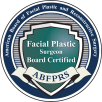Restylane® in NYC
THE PROCEDURE
Restylane® products are cosmetic dermal fillers that replace lost volume and restore youthful contours to the skin to smooth away moderate to severe facial wrinkles and folds, such as the lines from your nose to the corners of your mouth (nasolabial folds).
Restylane and Perlane® are made of hyaluronic acid. In the human body, natural hyaluronic acid provides volume and fullness to the skin. The hyaluronic acid in Restylane and Perlane has been modified slightly to last longer than the body's hyaluronic acid. The hyaluronic acid in Restylane and Perlane is produced by a biotechnical process.
Restylane and Perlane are hydrophilic or "water loving." The hydrophilic nature of these hyaluronic acid molecules and their three dimensional structure allows them to bind many times their own weight in water. As hyaluronic acid begins to degrade, each molecule binds to more water which helps to maintain its volume for about six months.
Restylane and Perlane contain no animal proteins. This limits any risk of animal-based disease transmission or allergic reactions. Restylane and Perlane contain trace amounts of gram-positive bacterial proteins and are contraindicated for patients with a history of allergies to such material. No allergy testing is required before use.
Where Can It be Used?
Restylane® and Perlane® are FDA-approved for the treatment of moderate to severe facial wrinkles and folds, such as the lines from your nose to the corners of your mouth (nasolabial folds)
Please observe the following after treatment with Restylane® and Perlane®.
- Cold compresses (a cloth dipped in cold water, wrung out, and applied to the injected area) may be used immediately after treatment to reduce swelling.
- Avoid touching the treated area within six hours following treatment, so you do not accidentally injure your skin while the area is numb. After that, the area can be gently washed with soap and water.
- Until there is no redness or swelling, avoid exposure of the treated area to intense heat (sun lamp or sunbathing).
- If you have previously suffered from facial cold sores, there is a risk that the needle punctures could contribute to another recurrence. Speak to your physician about medications that may minimize a recurrence.
- Avoid taking aspirin, non-steroidal anti-inflammatory medications, St. John's wort, and high doses of Vitamin E supplements for one week after treatment. These agents may increase bruising and bleeding at the injection site.
Please be sure to consult your healthcare provider about recommendations for a follow-up treatment.
Call for today for a consultation with Dr. Zimm. He has been specially trained in the administration of Restylane and will be happy to discuss whether it is right for you.
How Long Does Restylane Last?
Restylane® and Perlane® are proven to deliver long-lasting results. Studies have shown that Restylane lasts about six months. Perlane lasts at least six months in a majority of patients.* The patented stabilization technology helps maintain the cosmetic effect for those time periods.
How long the aesthetic correction lasts is very individual. Talk with your doctor about the benefits of scheduling a follow-up appointment in about six months.
What Can I Expect?
Restylane® and Perlane® require no pre-testing. Before being treated with Restylane and Perlane you should take a few precautions. Prior to treatment, avoid using aspirin, non-steroidal anti-inflammatory medications, St. John's wort, or high doses of Vitamin E supplements. Also, if you have previously suffered from facial cold sores, discuss this with your doctor, who may prescribe a medication to minimize recurrence.
Restylane and Perlane are injected directly into the skin in small amounts by an ultrafine needle. As with all injections, some patients may experience discomfort. To increase your comfort, your doctor will assess your need for pain management and determine what technique is right for you.
REVIEWS
FEATURED testimonials
FAQs
Frequently asked questions
The ideal age varies depending on the procedure. Some surgeries, like rhinoplasty, are often performed in late teens or early twenties, while others are more common among older adults seeking anti-aging treatments.
When performed by a board-certified plastic surgeon in a accredited facility, plastic surgery is generally safe. However, all surgical procedures carry inherent risks, and individual factors also play a role in safety.
Recovery time varies depending on the procedure and individual healing abilities. Some treatments may have minimal downtime, while others may require several weeks of recuperation.
Skilled surgeons strive to provide natural-looking outcomes. Open communication with your surgeon about your expectations and goals is crucial for achieving the results you desire.
Most surgeries result in some scarring, but plastic surgeons aim to minimize scarring through careful incision placement and suturing techniques. Scar management post-surgery can also help.
The cost varies by procedure and location. We do not accept insurance.
It's crucial to select a board-certified plastic surgeon with extensive experience in the specific procedure you're interested in. Reading reviews, checking credentials, and scheduling consultations can help with this decision.
Risks include infection, scarring, anesthesia complications, and dissatisfaction with results. An open discussion with your surgeon about potential risks and how they can be minimized is essential.




